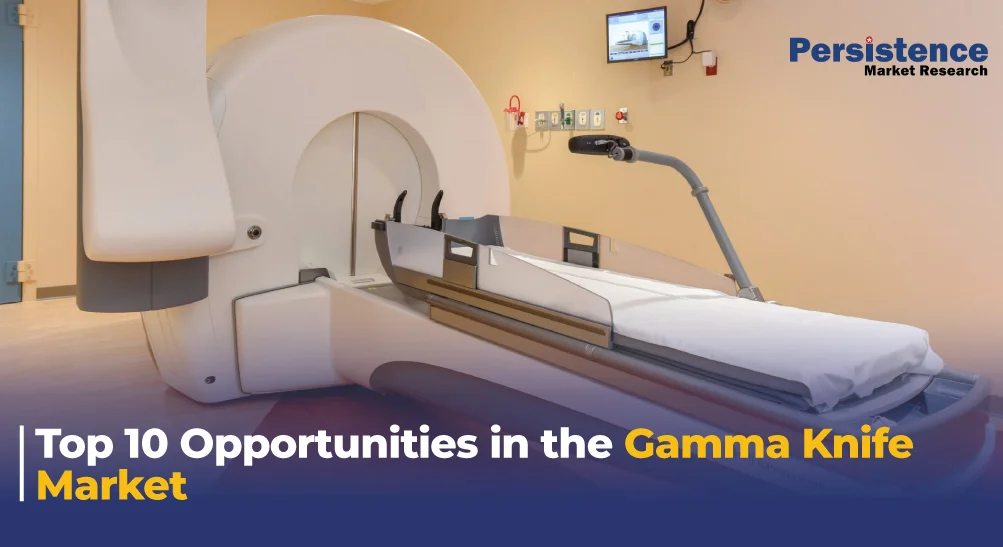- Blog
- Gamma Knife Market
Top 10 Opportunities in the Gamma Knife Market
Published On : 17 Oct 2025
The gamma knife market occupies a specialized position within neurosurgery and radiation oncology, focused on high-precision stereotactic radiosurgery for intracranial conditions. These systems deliver tightly collimated beams of gamma radiation to small targets in the brain with submillimeter accuracy, creating clinical value for brain metastases, arteriovenous malformations, trigeminal neuralgia, and selected benign lesions. The following ten opportunities describe where clinical practice, technology, and health systems intersect, illustrated with concise examples.

Geographic expansion into middle-income health systems
Growth in neurosurgical capacity across middle-income countries is creating demand for advanced intracranial treatments. Financing mechanisms, training programs, and referral consolidation have enabled some regional centers to introduce radiosurgery services. For example, a tertiary hospital in a rapidly urbanizing city established a radiosurgery suite that reduced patient travel times and shortened overall treatment pathways for patients with single brain metastases.
Rising incidence of brain metastases and survivorship patterns
Improved systemic cancer therapies have extended survival, and intracranial control has become a greater priority. Radiosurgery, including single-session Gamma Knife treatment, plays a larger role in controlling limited metastases while preserving cognitive function. A regional cancer network reported more referrals for stereotactic radiosurgery after adopting standardized follow-up imaging protocols for high-risk primary cancers.
Service, maintenance, and consumables as recurring revenue streams
Beyond the sale of capital equipment, ongoing quality assurance, source replacement, calibration, and imaging consumables represent sustained service demand. Several centers report that predictable maintenance cycles and vendor-managed QA programs reduce unexpected downtime and maintain throughput for radiosurgery clinics.
Fractionated and hybrid treatment paradigms
Although historically delivered in a single session, stereotactic radiosurgery is increasingly studied in fractionated schedules for large lesions or when normal tissue constraints require dose splitting. Clinical pathways that integrate staged radiosurgery with systemic therapy have emerged in select academic centers. An observational series described staged treatments for large benign meningiomas leading to acceptable tumor control and lower risk of radiation necrosis.
Advanced treatment planning and automation
Manual contouring and iterative plan optimization remain resource intensive. Artificial intelligence and automated planning tools are being evaluated to speed target delineation and dose calculation while maintaining plan quality. One academic center reported that automated segmentation reduced planner time for routine metastasis cases, enabling faster decision making on same-day treatments.
Imaging integration and MRI fidelity
Stereotactic accuracy depends on high-quality imaging and geometric fidelity. Protocol harmonization between Gamma Knife planning systems and MRI scanners has been prioritized to minimize spatial distortion for small targets. A center that implemented validated MRI protocols observed improved localization for lesions under 5 mm, reducing the need for repeat scans.
Health economics and payer interest in single-session care
Single-session intracranial radiosurgery can reduce hospital stays and downstream rehabilitation needs compared with open surgery for selected indications. Cost-effectiveness analyses and 90-day episode costing have been circulated in payer discussions, highlighting reductions in inpatient utilization for appropriate patient cohorts.
Training, credentialing, and remote mentorship
Operator experience correlates with procedural efficiency and outcomes. Structured training programs, immersive simulation, and tele-mentoring have been adopted to accelerate safe adoption in new centers. During the initial rollout at several institutions, remote proctoring of early cases supported local teams while preserving oversight from experienced stereotactic radiosurgery practitioners.
Refurbishment, retrofit, and middle-market offerings
Not all facilities can procure new systems. Certified refurbishment, software upgrades, and modular retrofits have been positioned as cost-effective alternatives to new installations. Hospitals that selected refurbishment have reported restored performance at substantially lower capital expenditure, enabling service expansion in constrained budgets.
Evidence generation and niche indications
Ongoing registry studies, prospective cohorts, and investigator-initiated trials are expanding the evidence base for radiosurgery in functional disorders, pediatric tumors, and select benign conditions. Multicenter registries tracking long-term seizure outcomes after radiosurgery have begun to inform referrals from neurology services, creating new clinical pathways for patient selection.
Conclusion
The gamma knife market reflects an interplay between precision technology, imaging fidelity, and evolving clinical practice. Key themes include geographic diffusion, changing oncologic needs, recurring service economics, and incremental innovations in planning and imaging. Examples from tertiary centers illustrate practical pathways by which radiosurgery programs have expanded access or refined indications. Continued emphasis on high-quality imaging, robust maintenance, and systematic evidence collection will influence adoption patterns and clinical integration. This landscape positions radiosurgery as a durable component of modern neuro-oncology, with growth shaped as much by system-level factors as by device-level performance.
Industry Report

Request Report Sample
Your privacy is important to us; your data is secure
Contact Us
Latest Reports
-
Wheat Bran Market by Product Type (Organic, Conventional), Application (Animal Feed, Food & Beverages, Nutraceuticals, Personal Care, Others), and Regional Analysis for 2026–2033
-
Tribulus Terrestris Extract Market by Product Type (Powder, Liquid, Capsule), Application (Dietary Supplements, Pharmaceutical, Cosmetics, Foods & Beverages), Source (Organic, Conventional), and Regional Analysis for 2026-2033
-
Water Truck Market by Truck Type (Highway, Off Road), Tanker Capacity (Below 6,000lt, 6,000-20,000lt, Above 20,000lt), End-Use (Mining & Construction, Agriculture, Firefighting, Potable Water Supply, Household, Commercial), and Regional Analysis for 2026–2033
-
Canola Lecithin Market by Product Type (Liquid, Powder, Granules), Application (Food & Beverages, Pharmaceutical, Cosmetics), Distribution Channel (Supermarket, Online Stores), and Regional Analysis for 2026-2033
-
Vinyl Acetate Ethylene (VAE) Copolymer Powder Market by Application (Adhesives, Paints & Coatings, Redispersible Polymer Powders, Textile Chemicals & Finishing, Paper & Packaging, Carpet Backing, Others), End-Use Industry (Construction & Building, Packaging & Paper, Textiles & Carpet, Consumer & Industrial Coatings, Automotive & Transportation, Others), and Regional Analysis for 2026–2033
